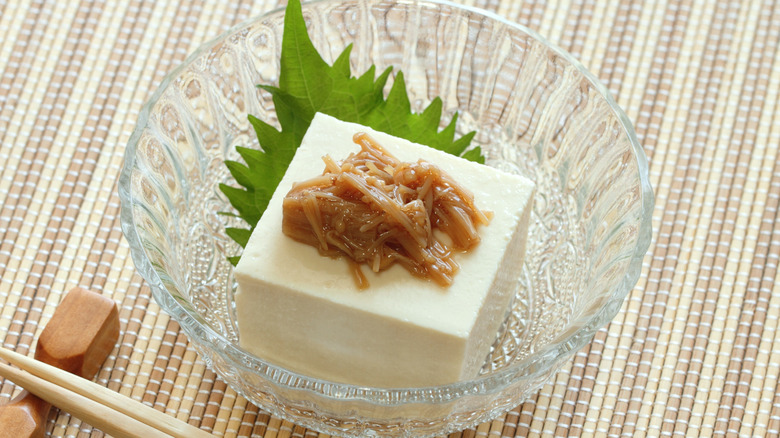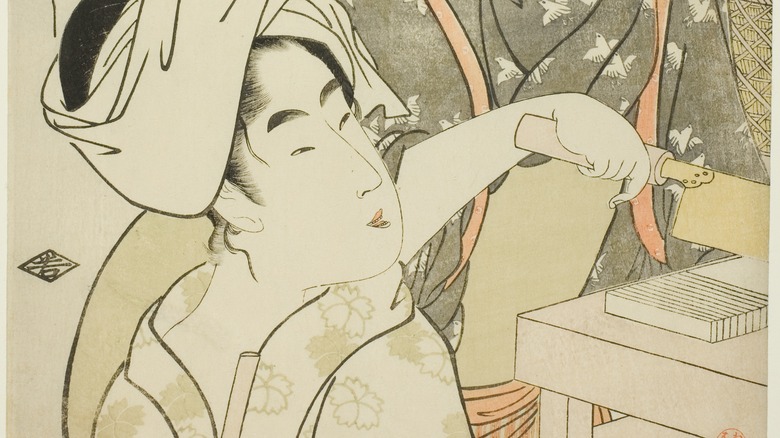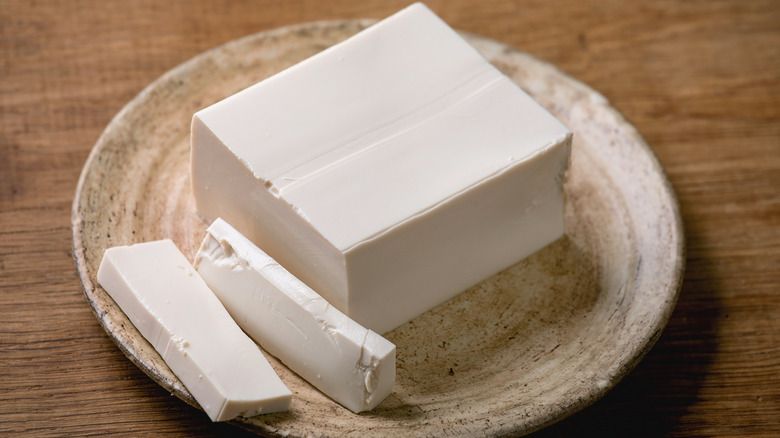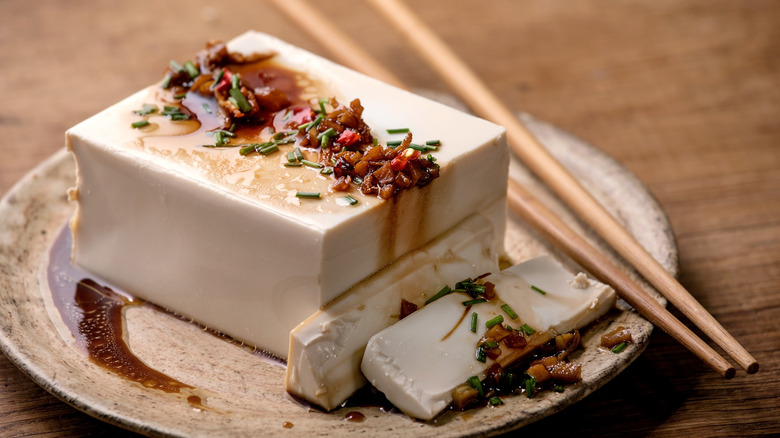Japan's Silky Hiyayakko Is More Complex Than It Seems
There are fewer more versatile and nutrition-packed foods out there than tofu — also called bean curd or dòufu in Chinese — which is made by coagulating soy milk into bean curds, which are then pressed into firm blocks. This tradition of making tofu has been around for over a thousand years, and legend has it that noble scholar Liu An inadvertently invented tofu while on a quest to find an immortal elixir.
In the time since, tofu has been manipulated and served many ways, which is only logical due to its malleable nature. It can be pressed, shaped and fried in a multitude of ways. There's also a multitude of different varieties, like silken tofu, firm, fried, stinky, and dried. While tofu is commonly associated with Chinese food, it's also a staple food in Japanese cuisine, found in dishes like miso soup and inarizushi. Another popular tofu dish is hiyayakko, which is a type of silken tofu served cold with ginger, bonito flakes, green onions, and soy sauce that's eaten as a side dish or appetizer. While its presentation is simple at a glance, hiyayakko has more complexity than meets the eye.
History of Hiyayakko
While tofu is pervasive in Japan today, when it was first introduced to the country sometime during the Nara period (between 710-794), it was first only eaten by the upper echelon of society, aristocrats and samurai families. Tofu's place as a luxury item reserved for the wealthy and titled remained until the Edo Period (1603-1867), where farmers were only allowed to eat tofu on certain holidays like the Obon festival and New Year's day. There was even a "Keian Proclamation" that forbid farmers from producing tofu, which was unfortunate as they ate it daily fried for breakfast and mixed in with lunch. Some sources may implicate that tofu was sold to the masses as early as 1500.
Either way, when the recipe book of a hundred different tofu delights, Tofu Hyakuchin, was published in 1782, hiyayakko appears in the book and it's assumed that the dish was already around for a while. The name literally translates to "cold (hiya) + tofu (yakko)", according to Sudachi Recipes.
How to make hiyayakko
Although hiyayakko is most commonly made with a silken tofu base, it can technically be made with firm tofu as well. Most importantly, the tofu must be chilled before you begin to prepare it, which will involve cutting the tofu into your preferred cube size for your dish. The real star of the show lies in the "yakumi", or garnishes of vegetables in the dish that accentuates the delicate flavor of the tofu. The sauce usually consists of sesame seeds, freshly minced ginger, soy sauce, sugar and dashi, which is mixed and then poured over the tofu. On top there are usually bonito flakes, sesame seeds, and chopped green onion as a garnish. One tip is to take the tofu out of the fridge the moment you begin preparing the sauce and toppings, otherwise "the umami of tofu itself will be lost if it is too cold," according to Chopstick Chronicles.
Hiyayakko is a fairly easy dish to whip up on a summer day when you don't want to turn on the stove or oven, though making your own silken tofu from scratch is a more time-intensive process.
Other variations on hiyayakko, how to eat and where to eat
In Japan, hiyayakko is usually eaten as a side dish or as a snack that is enjoyed with a cold beer, especially on scorching hot summer days that are particularly humid. When it's truly too hot to cook and you can't even be bothered to assemble a sauce, simply using a shoyu sauce on high-quality tofu will do the trick.
Since the silken or firm tofu base is so subtle, the dish is essentially like beginning with a blank white canvas on which you can add any toppings to your personal preference, from kimchi to natto to tomatoes. Most Japanese restaurants will likely offer hiyayakko, and if you happen to find yourself in Tokyo, blog Food in Japan recommends heading to Kiai Tofu Saitama, which uses tamahore soybean for it's tofu, "a type of soybean that is rarely used by tofu makers and require good skills to turn it into delicious tofu with a rich sweetness."



